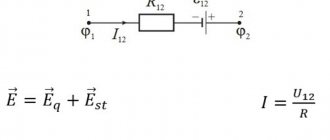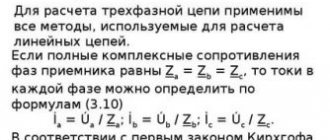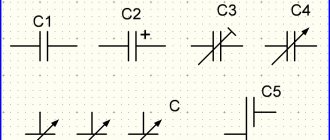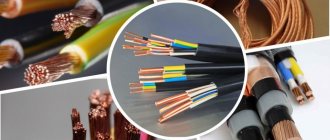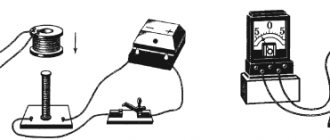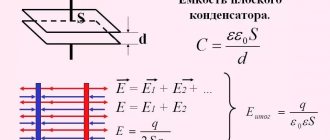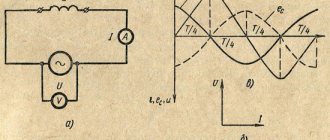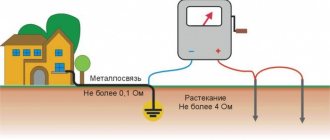Having connected the current source to the conducting circuit, using a multimeter, measure the potential difference (voltage) at the control points. It is easy to establish experimentally that electrical parameters change when using a resistor made of different materials. Similar results are obtained by experimenting with different cross sections. With the help of this article you can find out what the resistance of a conductor depends on. The knowledge gained will be useful for creating functional electrical circuits. They are needed for the correct repair and modernization of radio devices, ensuring personal safety during individual work operations.
During the experiment, it is easy to establish the dependence of the measured values on the parameters of the conductor
Concept of electrical resistance of a conductor
The classical definition explains electric current by the movement of “free” (valence) electrons. It is provided by the electric field created by the source. Movement in the metal is hampered not only by the normal components of the crystal lattice, but also by defective areas, impurities, and inhomogeneous areas. During collisions with obstacles, due to the transition of momentum into thermal energy, the temperature increases.
A good example is heating water with a boiler.
In gases, electrolytes and other materials the physics of the phenomenon is somewhat different. Linear relationships are observed in metals and other conductors. The basic relationships are expressed by the well-known formula of Ohm's law:
R (electrical resistance) = U (voltage) / I (current).
For convenience, the inverse quantity, conductivity (G = 1/R), is often used. It denotes the ability of a certain material to pass current with certain losses.
To simplify, the example of a water pipe is sometimes used. A moving fluid is an analogue of a current. Pressure is the equivalent of voltage. By decreasing (increasing) the cross section or position of the locking device, the conditions of movement are determined. In a similar way, the basic parameters of electrical circuits are changed using resistance (R).
For your information. The amount of liquid passing per unit time through the control section of the pipe is the equivalent of electrical power.
Determination of the resistive component
The electrical resistance of a material is the ratio of the magnitude of the current flowing and the voltage applied to it. For each specific element this ratio is different. To denote this physical quantity, use the letter R. When determining it, use the formula of Ohm’s law for a section of the chain:
R=U/I.
From the presented expression it is clear that the resistive component is the ratio of the potential on the conductor to the current strength on it. Thus, the higher the current value, the weaker the resistive component of the conductor; at higher voltages, the larger it is.
Additional Information. It is often said in common parlance that a resistive value “prevents” the voltage from endlessly increasing the current strength.
For any resistor produced in an industrial environment, there are about ten parameters that you need to pay attention to when choosing it. Its main parameter is resistance. This is a static characteristic for any conductor, specified during its production. Those. By applying more potential to a conducting element, only the current passing through it will change, but not its resistive component. Those. the U/I ratio remains unchanged.
Dependence on material properties
What does inductance depend on?
For standardization, the unit of measurement was 1 ohm. This resistance creates a column of mercury 1 square meter thick. mm, height – 1063 mm. Measurements are performed while maintaining zero temperature.
To simplify calculations, use the specific resistance value Rsp, which is created by conductors made of other materials (Length x Sectional area = 1,000 mm x 1 sq. mm).
Resistivity (conductivity)
The figure shows Rsp (silver) = 0.016. This means that a meter conductor with a normalized cross-sectional area of 1 mm sq. creates an electrical resistance of 0.016 ohms. Information about other materials can be taken from the reference book.
Dependence on voltage properties
Resistivity
After a simple transformation of the basic formula, you can create the correct expression for voltage:
U = I * R.
The current source generates electricity. The connected resistor consumes energy and is converted into heat. To maintain a certain current strength, it is necessary to set the appropriate voltage.
Measuring circuit, graphs
The graphs show the current-voltage characteristics of different devices. The first two demonstrate linear dependencies in which only the angle of inclination of the straight line changes (depending on the electrical resistance of the resistor).
If you connect a semiconductor diode, the graph will change significantly. From the figure, one can determine the low resistance in the region of positive values of U. However, after a change in polarity, an increase in negative voltage is not accompanied by a similar change in current. One-way conduction is, in particular, used to rectify signals.
In the last graph, the shifted zero current transition point indicates the EMF of the power source. As in the previous example, a small angle relative to the vertical indicates a low internal resistance of the battery.
Electric current in semiconductors
Semiconductors occupy an intermediate position between conductors and dielectrics in terms of their resistivity. A significant difference between semiconductors and metals can be considered the dependence of their resistivity on temperature. As the temperature decreases, the resistance of metals decreases, while for semiconductors, on the contrary, it increases. As the temperature approaches absolute zero, metals tend to become superconductors, and semiconductors - insulators. The fact is that at absolute zero, electrons in semiconductors will be busy creating covalent bonds between the atoms of the crystal lattice and, ideally, there will be no free electrons. As the temperature increases, some of the valence electrons can receive energy sufficient to break covalent bonds and free electrons will appear in the crystal, and vacancies are formed at the sites of the break, which are called holes. The vacant place can be occupied by a valence electron from a neighboring pair and the hole will move to a new place in the crystal. When a free electron meets a hole, the electronic bond between the atoms of the semiconductor is restored and the reverse process occurs - recombination. Electron-hole pairs can appear and recombine when a semiconductor is illuminated due to the energy of electromagnetic radiation. In the absence of an electric field, electrons and holes participate in chaotic thermal motion. Not only the resulting free electrons, but also holes, which are considered as positively charged particles, participate in the electric field in ordered motion. Current I
in a semiconductor it consists of electron
In
and hole
Ip
currents.
Semiconductors include chemical elements such as germanium, silicon, selenium, tellurium, arsenic, etc. The most common semiconductor in nature is silicon.
Comments and suggestions are accepted and welcome!
Geometry Dependency
Conductor inductance
From the section describing the specific parameters it is clear that the electrical resistance of the conductor depends on the length. If we take a silver sample (standardized cross-sectional area 1 sq. mm) with a length of 6.8 m, it is easy to calculate the value R = 6.8 * 0.016 = 0.1088 Ohm.
Other practical problems are solved in a similar way. To create a wire with an electrical resistance of 100 Ohms, you will need a silver wire 6,250 m long = 100/0.016. If we use a metal conductor made of iron, the length will be 833 m = 100/0.12.
The next decisive factor is the cross-sectional area. For clarity, you can use the example of pumping liquid from the main tank into two different containers. It is easy to create the necessary pressure by raising the main tank to a small height. By using tubes with different duct diameters, you can see the difference in the rate of filling of control volumes. If the readings are measured, if desired, it is easy to create proportional dependencies taking into account the initial geometric parameters of the transport channels.
The size of the conductors also matters. Electrical resistance (R) is equal to the specific value for a particular material (Rsp), multiplied by the length (L) and divided by the corresponding cross-section (S). If only the diameter is known, then for a round core you can apply the classic formula from a school geometry course:
S = (π * d2)/4 = (3.14 * d2)/4.
The length is calculated using the converted expression:
L = S * (R/ Rsp).
These proportions demonstrate what resistance depends on.
How to find resistance in a circuit?
It can be learned from Ohm's law, which relates current, voltage and resistance. In this case, it is calculated using the formula
resistance formula through Ohm's law
R – resistance, Ohm
U – voltage at the ends of the conductor, Volts
I – current flowing through the conductor, Amperes
That is, we just need to measure the voltage at the ends of a conductor and measure the current passing through it. Then apply the formula and calculate the conductor resistance. Let's solve a simple problem to consolidate.
Task
Calculate the resistance of the conductor if it is known that a voltage of 5 Volts is applied to it and the current passing through it is 0.1 Ampere.
Solution
In electronics and electrical engineering, special radioelements are used that resist electric current - resistors. You can read more about them in this article.
fixed resistors
Also here is a video where a very smart teacher explains what resistance is
Related topics to this article
Source
Calculation of conductor resistance
Simplified methods that need to be adjusted taking into account real conditions were discussed above. Thus, temperature has a significant effect on the conductivity of materials. In serial conductors (copper, aluminum), the value of this parameter increases in the proportion of 0.3-0.5% for each degree. In carbon-based compositions and electrolytes, the opposite effect is observed - a decrease in resistance.
Without holding strings or other devices for tricks, real levitation using superconductivity is provided
The experiment shown in the figure can be reproduced by lowering the temperature of the metal to “absolute zero” (-273°C). With such extreme cooling, the atomic lattice is fixed in a stable position.
This state creates ideal conditions for the movement of electrons. The absence of obstacles is accompanied by minimal losses, which explains the promising direction for creating efficient energy transmission lines. The example in the figure demonstrates improved operational parameters of transport communications. In this case, friction forces can be eliminated.
Combination of airless tube and superconductivity improves performance of advanced transport systems
It is clear that to improve economic performance it is necessary to increase the operating temperature while maintaining good conductivity. However, the latest scientific achievements in the relevant field allow us to count on positive results in the near future.
It should be emphasized! In practice, different computing technologies may be needed. For example, the material is unknown. It is difficult to identify it by external signs. For high-quality chemical laboratory analysis, in addition to the appropriate skills, special equipment is required.
However, if necessary, it is easy to derive the specific indicator:
Rsp = R * S / L.
Geometric parameters are measured with standard tools (ruler, caliper). According to a typical measurement scheme, electrical resistance is determined using a multimeter. To calculate Rsp, use the formula presented above. In the directory, select the position corresponding to the calculation result. Using the same technique, you can determine other unknown values, for example, the length of the cable in an underground route.
In actual calculations, the reactive components of the conductors are taken into account to improve accuracy. For example, the inductance of a long straight line is determined by the formula:
AND = (m0/2π) * L *(mc * ln(L/r) +1/4m,
Where:
- m – magnetic permeability of the material (o – constant, c – environment);
- r and L are the radius and length of the conductor, respectively.
As the frequency increases, it is necessary to take into account current spreading in the surface zone and vortex changes.
The theoretical knowledge presented will be useful for calculating and creating a rheostat - a device with adjustable resistance. They are needed to prevent electrical injuries using precise calculations of protective circuits and specialized circuit breakers (fuses).
Properties of conductors
The main characteristics of electrical conductors are:
- resistance,
- electrical conductivity.
When electrons move through a conducting substance, they collide with ions and atoms. This leads to resistance.
If a potential difference is created between two conductors, then an electric current will flow through the third one connecting them. The direction of its movement will be from greater potential to less. In this case, the carriers will be electrons that are not connected to each other, which determine the value of the electrical conductivity of the substance.
Electrical conductivity is the ability of a material to pass electric current. This indicator is inversely proportional to the resistance of the material, measured in siemens, see.
Depending on the charge carriers, electrical conductivity can be:
- electronic,
- ionic,
- hole
Conductor with electronic conductivity
Please note! A reliable conductor is characterized by low resistance to the flow of moving electrons and, accordingly, high electrical conductivity. The greatest conductivity is the property of the best conductor
The selection of conductive materials should be carried out in accordance with their properties:
- Electrical (resistivity and temperature coefficient of resistance);
- Physical (melting degree, density);
- Mechanical (resistance to stretching, bending, machine processing);
- Chemical (interaction with the environment, the possibility of connection during welding, soldering).
Metals without impurities have low resistivity. For alloys this figure increases. Resistance also increases with increasing temperature.
Important! When cooled to critical values, the resistance of most conductive substances drops to zero. This property is called superconductivity
When choosing conductors for electrical installations, power lines, protective grounding and other applications, it is important to take into account all the qualities of the materials
Video
Coffee capsule Nescafe Dolce Gusto Cappuccino, 3 packs of 16 capsules
1305 ₽ More details
Coffee capsules Nescafe Dolce Gusto Cappuccino, 8 servings (16 capsules)
435 ₽ More details
Powerline adapters
